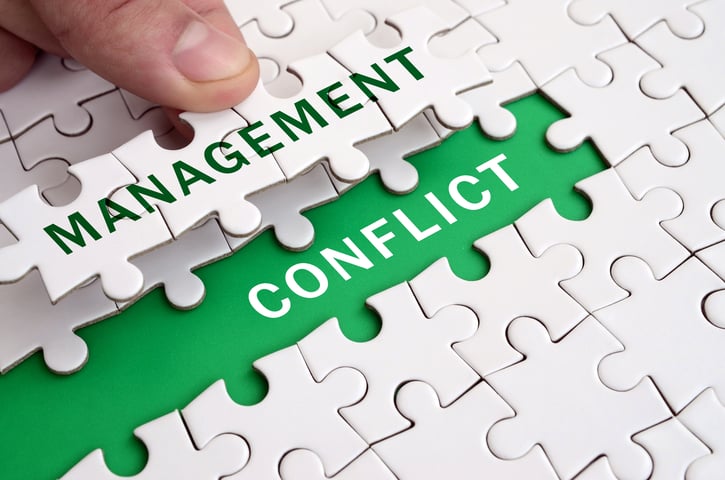What are conflict management styles?
Conflict management styles refer to individuals' approaches and techniques to effectively address and handle conflicts. These styles dictate how individuals interact and communicate when faced with differing opinions, needs, or concerns.
Understanding and utilizing different conflict management styles can greatly contribute to successful resolution and maintaining healthy relationships.
The main 5 conflict management styles
1. Avoiding conflict management style
The avoiding conflict management style involves consciously sidestepping conflicts or brushing them under the rug. This can occur when individuals prefer to delay confrontation or believe the issue will resolve itself over time.
While avoiding might provide temporary relief, it often fails to address underlying concerns and can lead to pent-up frustration or resentment.
Situations where avoiding might be appropriate:
- When emotions are running high, and a cooling-off period is necessary.
- In situations where the issue is trivial and not worth the potential fallout.
- When the parties involved lack the necessary information to address the conflict adequately.
Potential drawbacks and limitations:
- Unresolved conflicts can escalate over time, leading to larger issues.
- Avoiding conflict might be perceived as indifference or lack of engagement.
- The underlying problem remains untouched, potentially causing ongoing tension.
2. Accommodating conflict management style
The accommodating conflict management style involves prioritizing the needs and concerns of others over one's own. Individuals using this style are often willing to make concessions to ensure harmony and maintain relationships. While this approach can create positive interactions, it might lead to personal dissatisfaction if used excessively.
Instances where accommodating can be effective:
- When preserving the relationship is more important than the specific issue.
- In situations where one party has significantly more expertise or authority on the matter.
- When building goodwill for future collaboration is a primary goal.
Pitfalls and when it might not be advisable:
- Overusing this style can lead to personal resentment and unmet needs.
- It might discourage open dialogue and creative problem-solving.
- Accommodating might not be suitable for high-stakes conflicts where self-interest is essential.
3. Compromising conflict management style

The compromising style involves seeking middle ground and finding solutions where both parties make concessions. This approach requires open communication and a willingness to find a balance between conflicting needs. Compromising can be effective when immediate resolution is necessary, but it might not fully address the underlying issues.
Scenarios where compromising is a viable option:
- When time is limited, and a quick resolution is essential.
- In situations where both parties have equal power and can influence the outcome.
- When the conflict is preventing progress, and finding a temporary solution is crucial.
Balance between gains and concessions:
- Compromising can lead to solutions that partially satisfy both parties.
- However, it might not fully address the root causes of the conflict.
4. Competing conflict management style
The competing conflict management style involves pursuing one's own needs and goals without necessarily considering the concerns of others. This assertive approach can be effective in situations where quick decisions are required, but it can also create hostility and damage relationships.
When competing is suitable and can yield positive outcomes:
- In emergencies where immediate action is crucial.
- When unpopular decisions must be made for the greater good.
- In competitive environments where assertiveness is valued.
Risks of creating animosity or damaging relationships:
- Overusing the competing style can lead to resentment and alienation.
- It might suppress open communication and collaborative problem-solving.
5. Collaborating conflict management style
The collaborating conflict management style involves working together to find mutually beneficial solutions. This approach requires active communication, empathy, and a focus on long-term relationship building. Collaborating can lead to innovative solutions and strengthen relationships, but it can also be time-consuming and challenging.
Situations where collaboration leads to win-win solutions:
- Complex issues that require multiple perspectives and expertise.
- Building trust and fostering teamwork for future endeavors.
- When both parties have a shared interest in achieving the best possible outcome.
Challenges and prerequisites for successful collaboration:
- Collaborating requires open communication and active listening.
- It might be time-intensive, which can be challenging in fast-paced environments.
- A willingness to consider diverse viewpoints and invest in the relationship is crucial.
In managing conflicts, emotional intelligence plays a significant role regardless of the chosen conflict management style. Understanding one's emotions and those of others can guide individuals in selecting the most appropriate approach to resolving conflicts effectively.
By being aware of these five conflict management styles and their respective strengths and weaknesses, individuals can enhance their conflict resolution skills and promote positive outcomes in various scenarios.
Factors influencing style selection

1. Personal traits and tendencies
Each individual possesses unique traits and tendencies that shape their approach to conflict management.
Some individuals naturally lean towards collaborating, seeking win-win solutions through open communication and empathy.
Others might be inclined towards the accommodating style, prioritizing relationship harmony. Understanding one's own predispositions can help navigate conflicts more effectively.
2. Organizational or cultural norms
The environment in which conflicts arise plays a significant role in determining the preferred conflict management style. In some workplaces, a competitive culture might encourage using the competing style to assert dominance.
Alternatively, organizations that value teamwork and collaboration could foster the use of the collaborating style. Cultural norms also influence style selection, as different societies prioritize different approaches to conflict resolution.
Useful read: Exploring Company Culture Types: Building a Thriving Workplace for Success
3. The significance of emotional intelligence
Emotional intelligence is a cornerstone of effective conflict management. Those with high emotional intelligence can understand and manage their emotions and empathize with others.
This skill is crucial in all conflict management styles, enabling individuals to approach conflicts with empathy, remain composed under pressure, and foster constructive dialogue.
4. Power dynamics and the role of hierarchy
Power dynamics heavily influence the choice of conflict management style.
In situations with a clear power imbalance, such as a supervisor-subordinate relationship, accommodating or avoidant conflict styles might be adopted to maintain harmony and avoid backlash.
On the other hand, when power is balanced or in question, styles like compromising and collaborating may be more suitable, as they allow for negotiation and joint decision-making.
Adapting styles for different situations
Imagine a team facing a project deadline. In such situation an assertive, competing style might be required from the project manager to ensure timely completion.
Simultaneously, the team members might adopt a collaborative approach to discuss potential solutions and allocate tasks effectively. This highlights the importance of harmonizing styles to suit various aspects of a single situation.
Strategies for determining the most appropriate style in a given context
Here strategies for determining it:
-
Assess the stakes: Consider the gravity of the conflict and its potential consequences. For high-stakes conflicts involving significant outcomes, a collaborative or compromising style might be more fitting to ensure well-rounded solutions.
-
Analyze relationships: Evaluate the dynamics between the parties involved. If maintaining the relationship is paramount, accommodating or collaborating styles can help prevent strained interactions.
-
Consider time sensitivity: In time-sensitive scenarios, like resolving immediate issues in a crisis, adopting an assertive and quick-compromising style might be necessary to prevent escalation.
-
Evaluate power dynamics: If power is unevenly distributed, as in a hierarchical structure, consider how it influences the conflict. A supervisor might need to use an assertive style, while subordinates might opt for an accommodating or avoiding approach.
-
Weigh long-term goals: Reflect on long-term objectives. Collaborating or compromising can foster future cooperation, while competing might harm relationships.
Importance of assessing the potential impact of chosen styles
Selecting an appropriate conflict management style entails considering its potential repercussions. A manager who consistently employs a competitive style might damage team morale over time. Conversely, embracing a collaborative style can lead to innovative solutions and stronger team cohesion.
By critically evaluating the potential outcomes of each style, individuals can navigate workplace conflict more strategically, cultivating a healthier and more productive environment.
Benefits of skillful conflict management

Enhanced teamwork and relationships
Skillful conflict management has the remarkable ability to foster camaraderie among team members.
By adeptly utilizing conflict management skills, individuals can address differences while preserving relationships.
This cultivates an environment of mutual respect and understanding, where conflicts are seen as opportunities for growth rather than obstacles.
Improved problem-solving and decision-making
Applying an appropriate conflict management strategy can remarkably improve problem-solving and decision-making processes.
When conflicts are addressed openly and constructively, various perspectives come to light, leading to more comprehensive solutions.
This approach encourages individuals to collaborate, share insights, and collectively arrive at well-informed decisions.
Increased creativity and innovation
A specific conflict management style can pave the way for increased team creativity and innovation.
Embracing a compromising conflict style, for instance, encourages individuals to brainstorm and merge their ideas, often resulting in novel and imaginative solutions.
When conflict is managed constructively, it can fuel the generation of fresh ideas, invigorating the creative process.
Developing effective conflict management skills
1. Importance of self-awareness and self-regulation
Effective conflict management begins with a deep sense of self-awareness.
Recognizing one's own tendencies and preferred conflict style, whether an avoidant conflict style or a more assertive one, allows individuals to approach conflicts more intentionally.
Self-regulation complements this by enabling individuals to manage their emotional responses during conflicts, preventing knee-jerk reactions, and fostering a more measured approach.
2. Active listening and empathy as key components
Active listening and empathy are vital components of successful conflict management. Truly listening to the concerns of others, without immediate judgment or interruption demonstrates respect and openness.
Empathy takes this a step further, as it involves understanding the emotions and perspectives of those involved.
Integrating active listening and empathy into conflict management approaches can de-escalate tensions, encourage open dialogue, and create a foundation for productive resolution.
3. Role-play exercises and scenario-based training
Practical learning through role-play exercises and scenario-based training is invaluable for honing conflict management skills. These techniques offer a safe space to experiment with different conflict styles and approaches, allowing individuals to witness firsthand the outcomes of various strategies.
Role-playing enhances adaptability, preparing individuals for various scenarios, from resolving conflict to addressing workplace challenges. In developing effective conflict management skills, self-awareness, active listening, and empathy form the bedrock of productive interactions.
Conflict management in virtual work environments
In recent years, the rise of remote work and virtual teams has introduced new dynamics and challenges to conflict management. Addressing conflicts in a virtual work environment requires a different approach than traditional in-person settings.
Here are some unique challenges and strategies for effectively managing conflicts in virtual teams:
-
Limited non-verbal cues: In virtual settings, a significant portion of communication is non-verbal, and these cues can be lost or misinterpreted through text-based communication or even video calls. This can lead to misunderstandings and conflicts.
-
Communication barriers: Time zone differences, language barriers, and reliance on written communication can hinder effective communication, leading to miscommunication and escalated conflicts.
-
Reduced social interaction: Virtual teams might lack the spontaneous social interactions that occur naturally in physical office spaces. This can hinder the development of relationships and trust among team members, making conflict resolution more challenging.
-
Lack of immediate feedback: In-person interactions often allow for real-time feedback and resolution of issues. In virtual environments, delays in communication can exacerbate conflicts, leading to frustrations.
-
Technology challenges: Technical issues can disrupt communication, making it difficult to address conflicts promptly. Additionally, reliance on technology for communication can lead to misunderstandings due to glitches or misinterpreting messages.
Utilizing technology for effective conflict resolution in online settings:
-
Video conferencing: Video calls provide a more personal touch than text-based communication, allowing team members to observe facial expressions and body language, which can help them understand emotions and resolve conflicts.
-
Conflict resolution platforms: Utilize digital tools specifically designed for conflict resolution, such as collaborative whiteboards or online mediation platforms, to facilitate discussions and negotiations.
-
Real-time messaging: Instant messaging apps can help quickly address minor conflicts before they escalate. It's important to encourage open communication and create a safe space for team members to discuss their concerns.
-
Virtual team-building activities: Use technology to organize virtual team-building activities that promote understanding, trust, and cooperation among team members. A stronger team bond can prevent conflicts or address them more constructively.
Long-term conflict prevention strategies

Conflict prevention is a proactive approach that creates an environment where conflicts are less likely to occur.
By implementing these six detailed strategies, organizations can foster a culture of open communication, mutual respect, and collaboration, ultimately reducing the frequency and intensity of conflicts:
1. Clear communication channels and expectations
Establish transparent communication channels to ensure that information flows smoothly among team members.
Clear communication not only prevents misunderstandings but also provides an avenue for addressing concerns before they escalate.
Define expectations for regular check-ins, feedback sessions, and open forums where employees can voice their opinions and address potential issues.
2. Promote inclusivity and diversity
A diverse and inclusive workforce can bring various perspectives and ideas but can also lead to conflicts if not managed properly.
Implement diversity training programs that educate employees about different cultures, backgrounds, and communication styles.
Encourage empathy and respect for each other's differences, which can help prevent conflicts arising from misunderstandings or biases.
Useful Read: Mastering Diversity Management for Dynamic Organizations
3. Conflict resolution training
Offer conflict resolution training to employees at all levels of the organization. This training should cover active listening, effective communication, negotiation, and problem-solving skills.
Equipping employees with the tools to navigate conflicts constructively empowers them to address concerns before they escalate into larger issues.
4. Team building and trust-building activities
Engage in team-building activities that promote trust, collaboration, and camaraderie among team members. When colleagues have strong relationships, they are more likely to address conflicts openly and work together to find solutions.
Team-building activities can also enhance communication skills and foster a supportive work environment. Incorporating these detailed strategies into the organizational culture can contribute significantly to long-term conflict prevention.

Employee scheduling and Time-tracking software!
Conclusion
Conflicts are inherent in human interactions. This article discusses five conflict management styles: avoiding, accommodating, compromising, competing, and collaborating.
Adapting these styles contextually, considering personal traits and technology, is key.
In virtual work, technology and communication norms are vital. Mastering these styles facilitates constructive conflict resolution for better relationships.







